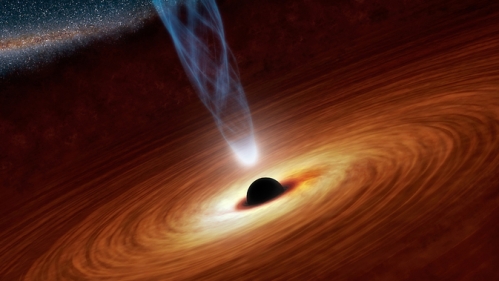
(Artist’s concept of a black hole and its corona, pictured here as the white light at the base of the jet – Photo Credit: NASA/JPL-Caltech)
NASA’s Nuclear Spectroscopic Telescope Array (NuSTAR) has witnessed an extreme and rare event in the region immediately surrounding a supermassive black hole.
NuSTAR discovered that a supermassive black hole’s gravity was affecting nearby X-ray light. In just a couple of days, the corona (particles that travel near the speed of light) fell towards the black hole.
“The corona recently collapsed in toward the black hole, with the result that the black hole’s intense gravity pulled all the light down onto its surrounding disk, where material is spiralling inward,” said Michael Parker of the Institute of Astronomy in Cambridge and lead author of a new paper on the findings.
As the corona moved closer to the black hole, the black hole’s gravity exerted a strong tug on the X-rays emitted by it. This resulted in extreme blurring and stretching of the X-ray light.
NuSTAR’s observations are a powerful example of Einstein’s theory of general relativity, which argues that gravity can bend space-time – the fabric that shapes our universe – and the light that travels through it.
 (Artist’s concept showing NuSTAR orbiting Earth – Photo Credit: NASA/JPL-Caltech)
(Artist’s concept showing NuSTAR orbiting Earth – Photo Credit: NASA/JPL-Caltech)
The black hole in this new study, known as Markarian 335 or Mrk 335, is located about 324 million light-years from Earth in the direction of the Pegasus constellation. It is one of the most extreme black holes ever measured.
The black hole squeezes about 10 million times the mass of our sun into a region only 30 times the diameter of the sun. It spins so rapidly that space and time are dragged around with it.
NASA’s Swift satellite has monitored Mrk 335 for years and recently witnessed a dramatic change in its X-ray brightness. NuSTAR was redirected to observe it, providing astronomers with a detailed look at what was occurring near Mrk 335’s event horizon (the region around a black hole from which light can no longer escape the pull of gravity).
Scientists do not yet know if Mrk 335’s corona will shift back, however NuSTAR’s observations have revealed more about the mysterious nature of black holes.
“We still don’t understand exactly how the corona is produced or why it changes its shape, but we see it lighting up material around the black hole” said NuSTAR Principal Investigator Fiona Harrison of the California Institute of Technology (Caltech). “NuSTAR’s unprecedented capability for observing this and similar events allows us to study the most extreme light-bending effects of general relativity.”